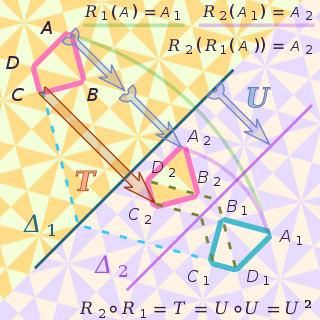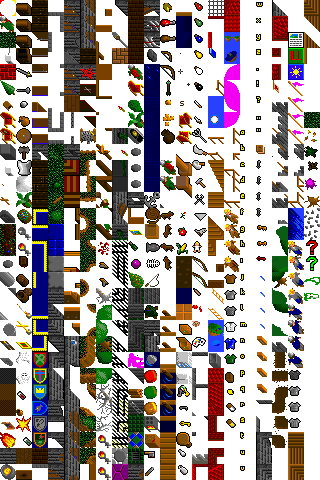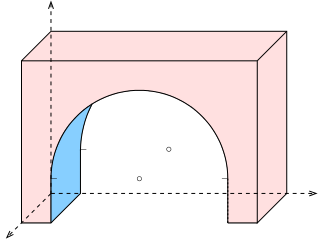
Isometric projection is a method for visually representing three-dimensional objects in two dimensions in technical and engineering drawings. It is an axonometric projection in which the three coordinate axes appear equally foreshortened and the angle between any two of them is 120 degrees.

An engineering drawing is a type of technical drawing that is used to convey information about an object. A common use is to specify the geometry necessary for the construction of a component and is called a detail drawing. Usually, a number of drawings are necessary to completely specify even a simple component. These drawings are linked together by a "master drawing." This "master drawing" is more commonly known as an assembly drawing. The assembly drawing gives the drawing numbers of the subsequent detailed components, quantities required, construction materials and possibly 3D images that can be used to locate individual items. Although mostly consisting of pictographic representations, abbreviations and symbols are used for brevity and additional textual explanations may also be provided to convey the necessary information.
Grid, The Grid, or GRID may refer to:
Coherence, coherency, or coherent may refer to the following:

In mathematics, an isometry is a distance-preserving transformation between metric spaces, usually assumed to be bijective. The word isometry is derived from the Ancient Greek: ἴσος isos meaning "equal", and μέτρον metron meaning "measure". If the transformation is from a metric space to itself, it is a kind of geometric transformation known as a motion.

A 3D projection is a design technique used to display a three-dimensional (3D) object on a two-dimensional (2D) surface. These projections rely on visual perspective and aspect analysis to project a complex object for viewing capability on a simpler plane.

Axonometric projection is a type of orthographic projection used for creating a pictorial drawing of an object, where the object is rotated around one or more of its axes to reveal multiple sides.
2.5D perspective refers to gameplay or movement in a video game or virtual reality environment that is restricted to a two-dimensional (2D) plane with little or no access to a third dimension in a space that otherwise appears to be three-dimensional and is often simulated and rendered in a 3D digital environment.

An isometric exercise is an exercise involving the static contraction of a muscle without any visible movement in the angle of the joint. The term "isometric" combines the Greek words isos (equal) and -metria (measuring), meaning that in these exercises the length of the muscle and the angle of the joint do not change, though contraction strength may be varied. This is in contrast to isotonic contractions, in which the contraction strength does not change, though the muscle length and joint angle do.

In three-dimensional geometry, a parallel projection is a projection of an object in three-dimensional space onto a fixed plane, known as the projection plane or image plane, where the rays, known as lines of sight or projection lines, are parallel to each other. It is a basic tool in descriptive geometry. The projection is called orthographic if the rays are perpendicular (orthogonal) to the image plane, and oblique or skew if they are not.

A vertical jump or vertical leap is the act of jumping upwards into the air. It can be an exercise for building both endurance and strength, and is also a standard test for measuring athletic performance. It may also be referred to as a Sargent jump, named for Dudley Allen Sargent.

A geodesic grid is a spatial grid based on a geodesic polyhedron or Goldberg polyhedron.

A tile-based video game is a type of video or video game where the playing area consists of small square graphic images referred to as tiles laid out in a grid. That the screen is made of such tiles is a technical distinction, and may not be obvious to people playing the game. The complete set of tiles available for use in a playing area is called a tileset. Tile-based games usually simulate a top-down, side view, or 2.5D view of the playing area, and are almost always two-dimensional.

An architectural drawing or architect's drawing is a technical drawing of a building that falls within the definition of architecture. Architectural drawings are used by architects and others for a number of purposes: to develop a design idea into a coherent proposal, to communicate ideas and concepts, to convince clients of the merits of a design, to assist a building contractor to construct it based on design intent, as a record of the design and planned development, or to make a record of a building that already exists.

Isometric video game graphics are graphics employed in video games and pixel art that use a parallel projection, but which angle the viewpoint to reveal facets of the environment that would otherwise not be visible from a top-down perspective or side view, thereby producing a three-dimensional (3D) effect. Despite the name, isometric computer graphics are not necessarily truly isometric—i.e., the x, y, and z axes are not necessarily oriented 120° to each other. Instead, a variety of angles are used, with dimetric projection and a 2:1 pixel ratio being the most common. The terms "3/4 perspective", "3/4 view", "2.5D", and "pseudo 3D" are also sometimes used, although these terms can bear slightly different meanings in other contexts.
A variety of computer graphic techniques have been used to display video game content throughout the history of video games. The predominance of individual techniques have evolved over time, primarily due to hardware advances and restrictions such as the processing power of central or graphics processing units.
An isometric exercise tool is a device used to exercise most body parts including the wrist and is often used as part of physical therapy or in order to build muscle strength in a low impact manner. Devices can range in size from large bulky machines used by physicians to small hand-held devices that can be used by an individual. Isometric devices have been used for centuries. The first devices did not display the users' output; nowadays there are devices that can digitally output the users force. Before that some devices used an analog format.

Brian Sterling-Vete is an English author, Guinness World Record Holder, motivational speaker, TV broadcaster, Director, Stage, Film and Television actor, stunt performer, martial arts expert, fitness expert and entrepreneur.
Isometry, in mathematics, refers to a distance-preserving transformation. Isometry may also refer to:

Axonometry is a graphical procedure belonging to descriptive geometry that generates a planar image of a three-dimensional object. The term "axonometry" means "to measure along axes", and indicates that the dimensions and scaling of the coordinate axes play a crucial role. The result of an axonometric procedure is a uniformly-scaled parallel projection of the object. In general, the resulting parallel projection is oblique ; but in special cases the result is orthographic, which in this context is called an orthogonal axonometry.












